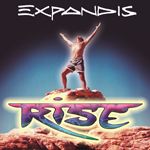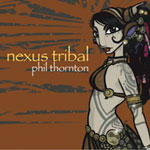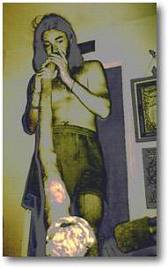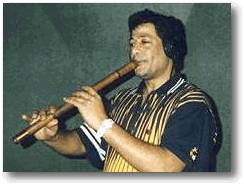 |
 |
 |
 |
 |
 |

|  |
 |
 |
 |
 |
 |
 |
 |
 |









 |
 |
 |
 |
 |

|
 |
 |
 |
 |
 |
 |
 |
Didgeridoo Sleeve notes from the album 'Initiation'. The Didgeridoo has fascinated me for as long as I can remember, I love its ability to create such a personel atmosphere and yet blend in with all sorts of musical textures. My first opportunity to use the didgeridoo in my music came unexpectedly while setting up my instruments on stage for my first solo concert back in 1986 at the Gateshead Arts Centre near Newcastle. A local student (I never did find out his name!) was practising the didgeridoo in another part of the building and it was not long before I was off searching the building for the source of the sound! He was happy to join me on stage during my concert, improvising the first of many such musical encounters. It was not until 1989 that the chance came to feature the didgeridoo on an album. I had been commissioned to compose an album to be recorded live at the Findhorn Foundation's Universal Hall in Scotland, the musical director for the project had arranged for a group of musicians to be on hand, which by chance included a didgeridoo player! The resulting track 'Terra Nova' was the most spontaneous sounding piece from the album of the concert 'Forever Dream'. |
|
 |
 |
| Steven Cragg | Darren Green |
| The following year I came across Steven Cragg at a Mandragora gig in Brighton, leading to the albums - 'Initiation', 'While the Green Man Sleeps' and 'Tibetan Horn'. By the time Steven was ready to resume his travels I had made contact with Darren Green, another great didgeridoo player from Brighton! Some amazing gigs came together around this period including the 'Simply Relax' festival in Amsterdam where we jammed with the excellent Berlin based 'Circular Breathing' didgeridoo band. Darren and I went on to work on the albums 'Shaman' and 'Sorcerer' together, and Darren has most recently been featured on the 'Immortal Egypt' album. Although I enjoy playing the didgeridoo myself, my technique is only good enough for simple rhythms and drones, when it comes to recording I much prefer to get a performance from a real player! |
|
Recorder |
|
 |
 |
Abdalla Helmy |
Hannah Burchell |
I have recently managed to get hold of a bass recorder and can't wait to use it in the studio! Since working with the Egyptian 'Nay' and 'Kawala' flutes I have also become much more interested in bringing performers in to the studio rather than being limited by my own technique. A good example of this new approach was Hannah Burchell's performance on the flageolet (low D) for the 'Solstice' album. |
|
Saz |
|
 |
 |
Sayed El Sha-er |
Mamdouh el Gebaly |
I'm happy if I can get a sound that feels personnel to me. As usual if I need to take the performance beyond my own skill level I will go looking for help from an expert player! |
|
|
|
|
 |
 |
 |
 |
 |

|
 |
 |
 |
 |
 |
 |

